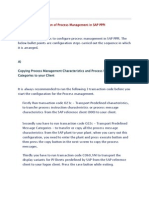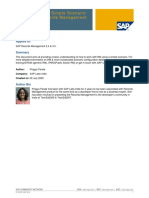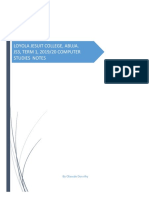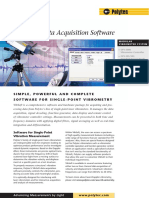Define Quota Arrangement Usage: SAP - Customizing Guide
Define Quota Arrangement Usage: SAP - Customizing Guide
Uploaded by
José FaiaCopyright:
Available Formats
Define Quota Arrangement Usage: SAP - Customizing Guide
Define Quota Arrangement Usage: SAP - Customizing Guide
Uploaded by
José FaiaOriginal Title
Copyright
Available Formats
Share this document
Did you find this document useful?
Is this content inappropriate?
Copyright:
Available Formats
Define Quota Arrangement Usage: SAP - Customizing Guide
Define Quota Arrangement Usage: SAP - Customizing Guide
Uploaded by
José FaiaCopyright:
Available Formats
SAP – Customizing Guide
Define Quota Arrangement Usage
You can use quota arrangements in connection with the following:
Purchase orders
Scheduling agreement delivery schedules
Planned orders
Purchase requisitions
Materials planning and control
In this step, you specify for each material master record which quota arrangement rule is allowed. You group
the usage combinations you have chosen under keys. You then store these keys at plant level in the
material master record.
Activities
Define the quota arrangement rules.
printed by Ahmad Rizki 211 of 341
SAP – Customizing Guide
RFQ/Quotation
In this section, you make the system settings for requests for quotation (RFQs) and quotations.
Define Number Ranges
In this step, you maintain the number ranges for the following purchasing documents:
RFQ/quotation
Purchase order
Contract
Scheduling agreement
Standard settings
The following number ranges are predefined in the standard SAP System:
Purchase order:
o Internal number assignment 4500000000 to 4599999999
o External number assignment 4100000000 to 4199999999
RFQ/quotation:
o Internal number assignment 6000000000 to 6099999999
o External number assignment 6100000000 to 6199999999
Contract:
o Internal number assignment 4600000000 to 4699999999
o External number assignment 4400000000 to 4499999999
Scheduling agreement:
o Internal number assignment 5500000000 to 5599999999
o External number assignment 5600000000 to 5699999999
Recommendation
SAP recommends that you accept the settings defined in the standard system. In this case, no action is
required on your part.
printed by Ahmad Rizki 212 of 341
SAP – Customizing Guide
Actions
Define the number ranges for your purchasing documents.
Notes on transport
The settings for the number ranges are not covered by the automatic transport facility.
You transport number range objects as follows:
In the initial screen, choose Interval -> Transport.
Note that all intervals for the selected number range object are deleted in the target system first. After the
import, only the intervals you export are present. The number statuses are imported with their values at the
time of export.
Dependent tables are not transported or converted.
Define Document Types
The SAP System manages RFQs and quotations as documents.
You can group RFQs and quotations into any number of document types.
In this step, you can do the following:
Create new document types
Define item interval
Define admissible follow-on document types
printed by Ahmad Rizki 213 of 341
SAP – Customizing Guide
Assign document types to a number range group
Define number range interval
Choose type of number assignment
o internal
o external
Choose update group
The update group determines how the data from the document header is updated in the statistics
file.
Standard settings
The standard SAP R/3 System contains the following defaults:
for document types
"AN" (RFQs and quotations)
for number ranges
o internal from 6000000000 to 6099999999
o external from 6100000000 to 6199999999
SAP recommendation
SAP recommends that you accept the settings defined in the standard system. In this case, no action is
required on your part.
Activities
1. Check the document types and number ranges.
2. Change the following according to your requirements
o the document types
o the number ranges
Notes on transport
You transport number range objects as follows:
In the initial screen, choose Interval -> Transport.
Note that all intervals for the selected number range object are deleted in the target system first. After the
import, only the intervals you export are present. The number statuses are imported with their values at the
time of export.
Dependent tables are not transported or converted.
printed by Ahmad Rizki 214 of 341
SAP – Customizing Guide
Release Procedure for RFQs
In this section, you set up a release procedure for requests for quotations (RFQs).
Requirements
If you want to use workflow to release RFQs, you must make the standard and basic settings for workflow
(Basis -> Business Management -> SAP Business Workflow).
How do you set üp a release procedure for RFQs?
To set up the release procedure, you must make a series of settings in Customizing. This section provides
you with an overview of the necessary activities.
You must perform the following steps:
1. Create characteristics and classes
For more on this topic, see Edit Characteristics and Edit Classes.
Note
If you wish to link your release procedure to workflow, you must perform steps 2 and 3. You make these
settings in Customizing for Business Workflow (Basis -> Business Management).
Otherwise, continue with step 4.
2. Define organizational plan
For more on this topic, see Edit Organizational Plan.
3. Assign standard tasks and activate event-receiver linkage.
For more on this topic, see Perform Task- Specific Customizing.
printed by Ahmad Rizki 215 of 341
You might also like
- IATF 16949:2016 Audit Guide and Checklist 2nd EditionFrom EverandIATF 16949:2016 Audit Guide and Checklist 2nd EditionRating: 4.5 out of 5 stars4.5/5 (10)
- RICEFW Interview QuestionsDocument24 pagesRICEFW Interview QuestionsRAVI100% (7)
- SAP Variant Configuration: Your Successful Guide to ModelingFrom EverandSAP Variant Configuration: Your Successful Guide to ModelingRating: 5 out of 5 stars5/5 (2)
- Engine Simulator Board V1.4 ManualDocument7 pagesEngine Simulator Board V1.4 ManualKi Rekso Aljero60% (5)
- SAP Testing Process and ScenariosDocument5 pagesSAP Testing Process and ScenariosSunitha GubbalaNo ratings yet
- SAP SD Routines ExplanationDocument7 pagesSAP SD Routines ExplanationSarosh100% (1)
- S4HANA Extended Production Engineering and Operations (PEO) Part 1 - Configuration SettingsDocument26 pagesS4HANA Extended Production Engineering and Operations (PEO) Part 1 - Configuration Settingsshishir174No ratings yet
- SAP Transportation Management (TM) IntroducitonDocument34 pagesSAP Transportation Management (TM) Introducitonmohan babu100% (4)
- SAP Service Management: Advanced ConfigurationFrom EverandSAP Service Management: Advanced ConfigurationRating: 4.5 out of 5 stars4.5/5 (3)
- The Official Supply Chain Dictionary: 8000 Researched Definitions for Industry Best-Practice GloballyFrom EverandThe Official Supply Chain Dictionary: 8000 Researched Definitions for Industry Best-Practice GloballyRating: 4 out of 5 stars4/5 (4)
- Define Screen Layout at Document Level: SAP - Customizing GuideDocument5 pagesDefine Screen Layout at Document Level: SAP - Customizing GuideJosé FaiaNo ratings yet
- SAP - Customizing Guide: Printed by Ahmad RizkiDocument11 pagesSAP - Customizing Guide: Printed by Ahmad RizkiJosé FaiaNo ratings yet
- Running Hyperion Planning On A LaptopDocument75 pagesRunning Hyperion Planning On A Laptopjturrell17100% (1)
- Schematic Diagram For Model 2216: All VersionsDocument1 pageSchematic Diagram For Model 2216: All VersionsZa RacsoNo ratings yet
- Set Up Stock Transport Requisition: SAP - Customizing GuideDocument5 pagesSet Up Stock Transport Requisition: SAP - Customizing GuideJosé FaiaNo ratings yet
- Maintain Quotation Comments: SAP - Customizing GuideDocument5 pagesMaintain Quotation Comments: SAP - Customizing GuideJosé FaiaNo ratings yet
- Purchasing Info Record: Define Number RangesDocument5 pagesPurchasing Info Record: Define Number RangesJosé FaiaNo ratings yet
- SAP MM - Configuration StepsDocument23 pagesSAP MM - Configuration StepsSUCCESS SAPNo ratings yet
- SAP PP Configuration DocumentDocument19 pagesSAP PP Configuration DocumentjayakishorerangapuramNo ratings yet
- What Is The Difference Between A User Exit and Routines in SAP SDDocument7 pagesWhat Is The Difference Between A User Exit and Routines in SAP SDGaphur shaikNo ratings yet
- BRFplusDocument64 pagesBRFplussapsd540No ratings yet
- SAP PP ConfigurationDocument15 pagesSAP PP ConfigurationMohammed R Siddiqui100% (1)
- SAP_PP_Configuration_Steps_linkedinDocument17 pagesSAP_PP_Configuration_Steps_linkedinKuntrapakam BhargavNo ratings yet
- Routing SDocument24 pagesRouting SanjitachinkiNo ratings yet
- SAP - Customizing Guide: Printed by Ahmad RizkiDocument6 pagesSAP - Customizing Guide: Printed by Ahmad RizkiJosé FaiaNo ratings yet
- Study Routing Material Contributed by Ulhas KavleDocument23 pagesStudy Routing Material Contributed by Ulhas Kavlesaisuni.mNo ratings yet
- SAP Materials Management Question BankDocument66 pagesSAP Materials Management Question BankHarshan ArumugamNo ratings yet
- SAP BasisDocument5 pagesSAP BasisRohit KumarNo ratings yet
- Configuration of Batch DeterminationDocument24 pagesConfiguration of Batch DeterminationknmitraNo ratings yet
- SAP PM Configuration Part 2Document22 pagesSAP PM Configuration Part 2hari.s.sNo ratings yet
- PP QuestionaireDocument8 pagesPP QuestionaireVara LakshmiNo ratings yet
- Automatic Account Assignment OKB9 Does Not Work1Document17 pagesAutomatic Account Assignment OKB9 Does Not Work1kprakashmm0% (1)
- SAP PPPI ConfigurationDocument11 pagesSAP PPPI ConfigurationVenkat Chakri100% (2)
- Sap SDocument17 pagesSap SKarthik BhiravajoshulaNo ratings yet
- SAP MM Config 10Document32 pagesSAP MM Config 10Edgardo Ascanio RegueiraNo ratings yet
- SAP MM Config 9Document24 pagesSAP MM Config 9Edgardo Ascanio RegueiraNo ratings yet
- Help DocumentDocument679 pagesHelp DocumentRavi KumarNo ratings yet
- An Introduction About IPC: SCE Sales Configuration Engine SPE Sales Pricing Engine PME Product Modeling EnvironmentDocument9 pagesAn Introduction About IPC: SCE Sales Configuration Engine SPE Sales Pricing Engine PME Product Modeling EnvironmentbornartistNo ratings yet
- Functional Specification SampleDocument7 pagesFunctional Specification SampleLokesh Dora0% (1)
- Production ExecutionDocument114 pagesProduction ExecutionVijayabhaskar PapanaNo ratings yet
- SAP SD Interview Questions & Answers With ExplanationsDocument116 pagesSAP SD Interview Questions & Answers With ExplanationsGiri Dhar100% (1)
- MRPDocument27 pagesMRPRAMAKRISHNA.GNo ratings yet
- Concepts in Workflow Release Strategy - SAP CommunityDocument51 pagesConcepts in Workflow Release Strategy - SAP Communitymohamed.hassballah00No ratings yet
- Set Tolerance Limits For Price Variance: SAP - Customizing GuideDocument5 pagesSet Tolerance Limits For Price Variance: SAP - Customizing GuideJosé FaiaNo ratings yet
- SAP - Customizing Guide: ExampleDocument5 pagesSAP - Customizing Guide: ExampleJosé FaiaNo ratings yet
- SAP SCM Demand Planning: Best Practice For Solution ManagementDocument12 pagesSAP SCM Demand Planning: Best Practice For Solution ManagementSagar BabarNo ratings yet
- Operations Concern in SAP S - 4HANADocument22 pagesOperations Concern in SAP S - 4HANASurendraNo ratings yet
- Basic Settings For MES IntegrationDocument25 pagesBasic Settings For MES Integrationrupasapsongs songsNo ratings yet
- ORDER TYPE Depnt ParameterDocument3 pagesORDER TYPE Depnt ParameterSrinivas CharyNo ratings yet
- Requirement Routines - Output ControlDocument3 pagesRequirement Routines - Output ControlSOUMEN DASNo ratings yet
- Results Analysis (RA) - SAP Project SystemsDocument4 pagesResults Analysis (RA) - SAP Project Systemskalkikali0% (1)
- ProductionDocument563 pagesProductionShine KaippillyNo ratings yet
- Sap Fi Notes ProjectDocument243 pagesSap Fi Notes Projectjoy_dipdasNo ratings yet
- SAP RMS Sample Project PDFDocument25 pagesSAP RMS Sample Project PDFashokkrpNo ratings yet
- APO Data For Volum TestingDocument11 pagesAPO Data For Volum TestingSagar BabarNo ratings yet
- Test Data For Volume Testing - SAP SCM Demand Planning: Best Practice For Solution ManagementDocument12 pagesTest Data For Volume Testing - SAP SCM Demand Planning: Best Practice For Solution ManagementSagar BabarNo ratings yet
- Repitative ManuDocument19 pagesRepitative ManuyogeshNo ratings yet
- SAP SD Interview Questions & Answers With ExplanationsDocument116 pagesSAP SD Interview Questions & Answers With ExplanationsMiguel Alberto Maldonado Gonzalez100% (1)
- Sap 70 Interview QuestionDocument58 pagesSap 70 Interview QuestionKiran BharatiNo ratings yet
- SAP PP ConfigurationsDocument7 pagesSAP PP ConfigurationsArvind Sharma100% (1)
- SAP PR Release Strategy Concept and Configuration Guide: A Case StudyFrom EverandSAP PR Release Strategy Concept and Configuration Guide: A Case StudyRating: 4 out of 5 stars4/5 (6)
- 1Document1 page1José FaiaNo ratings yet
- Land TransportationDocument1 pageLand TransportationJosé FaiaNo ratings yet
- WManager 114 115Document2 pagesWManager 114 115José FaiaNo ratings yet
- 3-3-2 Create A Service Order in The CIC.: (C) Sap Ag IUT221 3-61Document2 pages3-3-2 Create A Service Order in The CIC.: (C) Sap Ag IUT221 3-61José FaiaNo ratings yet
- SAP - Customizing Guide: ExampleDocument5 pagesSAP - Customizing Guide: ExampleJosé FaiaNo ratings yet
- WManager 122 123Document2 pagesWManager 122 123José FaiaNo ratings yet
- Set Tolerance Limits For Price Variance: SAP - Customizing GuideDocument5 pagesSet Tolerance Limits For Price Variance: SAP - Customizing GuideJosé FaiaNo ratings yet
- Assign Purchasing Organization: SAP - Customizing GuideDocument6 pagesAssign Purchasing Organization: SAP - Customizing GuideJosé FaiaNo ratings yet
- Tools: SAP - Customizing GuideDocument6 pagesTools: SAP - Customizing GuideJosé FaiaNo ratings yet
- Sales: SAP - Customizing GuideDocument5 pagesSales: SAP - Customizing GuideJosé FaiaNo ratings yet
- SAP - Customizing Guide: Printed by Ahmad RizkiDocument11 pagesSAP - Customizing Guide: Printed by Ahmad RizkiJosé FaiaNo ratings yet
- Define, Copy, Delete, Check Sales Organization: SAP - Customizing GuideDocument11 pagesDefine, Copy, Delete, Check Sales Organization: SAP - Customizing GuideJosé FaiaNo ratings yet
- SAP - Customizing Guide: Printed by Ahmad RizkiDocument6 pagesSAP - Customizing Guide: Printed by Ahmad RizkiJosé FaiaNo ratings yet
- Assign Purchasing Organization To Plant: SAP - Customizing GuideDocument11 pagesAssign Purchasing Organization To Plant: SAP - Customizing GuideJosé FaiaNo ratings yet
- Blocking Reasons: SAP - Customizing GuideDocument5 pagesBlocking Reasons: SAP - Customizing GuideJosé FaiaNo ratings yet
- Guardmaster Safety Relays: User ManualDocument84 pagesGuardmaster Safety Relays: User ManualwonderfuldemoNo ratings yet
- Agile Infrastructure Management With: Digital SecurityDocument11 pagesAgile Infrastructure Management With: Digital SecurityAkhil RajendranNo ratings yet
- Database Management Systems: Unit - IDocument78 pagesDatabase Management Systems: Unit - IDheeraj NaniNo ratings yet
- V: Building Iot With Arduino &raspberry Pi: VunitDocument41 pagesV: Building Iot With Arduino &raspberry Pi: VunitPonraj ParkNo ratings yet
- StoneOS WebUI User Guide A-12Document1,389 pagesStoneOS WebUI User Guide A-12(unknown)No ratings yet
- Modbus VLT2800Document35 pagesModbus VLT2800DanhVôNo ratings yet
- Devendran 9944@gmail DotcomDocument3 pagesDevendran 9944@gmail DotcomSamruddhi ThengdiNo ratings yet
- Pro II Basics TutorialDocument2 pagesPro II Basics TutorialRanjit PaulNo ratings yet
- Jeas 0815 2395Document6 pagesJeas 0815 2395Aishwarya KarangaleNo ratings yet
- Data Mining Lab 02 - Truong Quang Tuong - ITITIU20130Document8 pagesData Mining Lab 02 - Truong Quang Tuong - ITITIU20130Tường TrươngNo ratings yet
- Term1, Js3 Notes StudentsDocument20 pagesTerm1, Js3 Notes StudentsTae LemaeNo ratings yet
- USRobotics 5637-OEM ManualDocument144 pagesUSRobotics 5637-OEM ManualDaniel Pedrosa MorilloNo ratings yet
- Alcatel Omnipcx Enterprise: Secret IdDocument16 pagesAlcatel Omnipcx Enterprise: Secret IdAriel BecerraNo ratings yet
- Portable and Low-Cost 12-Lead ECG DeviceDocument7 pagesPortable and Low-Cost 12-Lead ECG Deviceibrahim hashimNo ratings yet
- CC - Activity: Name: Syed Hamza Ibrar Gillani Roll No: FA-2019-BSSE-060 Submitted To: Mam Fouzia RathoreDocument3 pagesCC - Activity: Name: Syed Hamza Ibrar Gillani Roll No: FA-2019-BSSE-060 Submitted To: Mam Fouzia RathoreSyed Hamza Ibrar ShahNo ratings yet
- TDDocument66 pagesTDsophia khanNo ratings yet
- VibsoftDocument6 pagesVibsoftok59No ratings yet
- BD9 S4hana2022 BPD en UsDocument74 pagesBD9 S4hana2022 BPD en UsPrathamesh ParkerNo ratings yet
- Systolic ArchitectureDocument9 pagesSystolic ArchitectureRohini ShahNo ratings yet
- CBS Industry Company Limited: uPVC Window Making MachineDocument18 pagesCBS Industry Company Limited: uPVC Window Making MachineMohd DaudNo ratings yet
- HDB e 30Document74 pagesHDB e 30elderNo ratings yet
- Computer Organization and Architecture Notes 2 - TutorialsDuniyaDocument179 pagesComputer Organization and Architecture Notes 2 - TutorialsDuniyaRohit SharmaNo ratings yet
- Robotics LabDocument2 pagesRobotics LabpasinduNo ratings yet
- Experiment # 09: Objective: To Study The Over Voltage Protection of DC Power Supply System (CLO 1) ApparatusDocument20 pagesExperiment # 09: Objective: To Study The Over Voltage Protection of DC Power Supply System (CLO 1) ApparatusRasheed Shah100% (1)
- Computer Application - MS FarizahDocument5 pagesComputer Application - MS Farizahjia jun soongNo ratings yet
- GDE Clarus600-680UserGuideDocument362 pagesGDE Clarus600-680UserGuideYahsé Rojas ChallaNo ratings yet







































































































